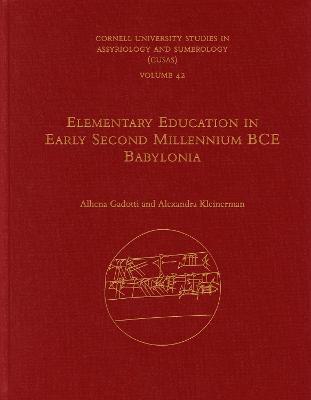Elementary education in early second millennium BCE Babylonia
- ISBN: 9781646021383
- Editorial: Pennsylvania State University Press
- Fecha de la edición: 2021
- Lugar de la edición: Indiana. Estados Unidos de Norteamérica
- Colección: Cornell University studies in Assyriology and Sumerology (CUSAS)
- Encuadernación: Cartoné
- Medidas: 28 cm
- Nº Pág.: 304
- Idiomas: Inglés

In this volume, Alhena Gadotti and Alexandra Kleinerman investigate how Akkadian speakers learned Sumerian during the Old Babylonian period in areas outside major cities. Despite the fact that it was a dead language at the time, Sumerian was considered a crucial part of scribal training due to its cultural importance. This book provides transliterations and translations of 715 cuneiform scribal school exercise texts from the Jonathan and Jeanette Rosen Ancient Near Eastern Studies Collection at Cornell University. These tablets, consisting mainly of lexical texts, illustrate the process of elementary foreign-language training at scribal schools during the Old Babylonian period. Although the tablets are all without provenance, discrepancies between these texts and those from other sites, such as Nippur and Ur, strongly suggest that the texts published here do not come from a previously studied location. Comparing these tablets with previously published documents, Gadotti and Kleinerman argue that elementary education in Mesopotamia was relatively standardized and that knowledge of cuneiform writing was more widespread than previously assumed. By refining our understanding of education in southern Mesopotamia, this volume elucidates more fully the pedagogical underpinnings of the world's first curriculum devised to teach a dead language. As a text edition, it will make these important documents accessible to Assyriologists and Sumerologists for future study
List of IllustrationsPrefaceAcknowledgementsList of AbbreviationsCatalog of Texts1. Introduction2. Historical Background3. The Nippur Curriculum4. The Sumerian Elementary Curriculum Outside Nippur 4.1. Ur 4.2. Uruk 4.3. Sippar 4.4. Kish 4.5. Susa 4.6. Other Sites 4.7. The Schoyen Collection 4.8. The Cotsen Collection 4.9. Discussion5. The Rosen School Tablets 5.1. Tablet Typology and Tablet Shape 5.1.1. Type I (Multicolumn) 5.1.2. Type II (Student-Teacher) 5.1.3. Type III (Imgida) 5.1.4. Type IV (Lenticular) 5.1.5. Prisms 5.1.6. Other 5.2. The Exercises 5.2.1. Sign Exercises 5.2.2. Personal Names 5.2.2.1. Sumerian Personal Names 5.2.2.2. Akkadian Personal Names 5.2.2.3. Sumero-Akkadian Personal Names 5.2.3. Legal Phrasebooks 5.2.4. Thematic Lists 5.2.4.1. Ura 1: Trees and Wooden Items 5.2.4.2. Ura 2: Crafts 5.2.4.3. Ura 3: Animals and Cuts of Meat 5.2.4.4. Ura 4: Objects Found in Nature 5.2.4.5. Ura 5: Geography 5.2.4.6. Ura 6: Food Items 5.2.4.7. Other Thematic Texts: ED Word List C 5.2.5. Advanced Sign Lists 5.2.6. Lists of Human Beings 5.2.7. Acrographic Lists 5.2.8. Ugu-Mu 5.2.9. God Lists 5.2.10. Proverbs 5.2.11. Literary Text6. Signatures7. Conclusion8. ConventionsTransliterations, Translations, and Remarks1. Sign Exercise Lists2. Sumerian Personal Name Lists3. Akkadian Personal Name Lists4. Mixed Personal Name Lists5. Legal Phrasebooks6. Ura 1: Wooden Items7. Ura 2: Crafts8. Ura 3: Domestic and Wild Animals, Cuts of Meat9. Ura 4: Stones; Plants; Birds; Fish; Textiles10. Ura 5: Geography11. Ura 6: Food Items12. Thematic, Other13. Advanced Sign Lists14. List of Human Beings15. Acrographic Lists16. Ugumu17. God Lists18. Proverbs19. Model Contracts20. Literature21. Undetermined ListsAppendixReferencesPlates






